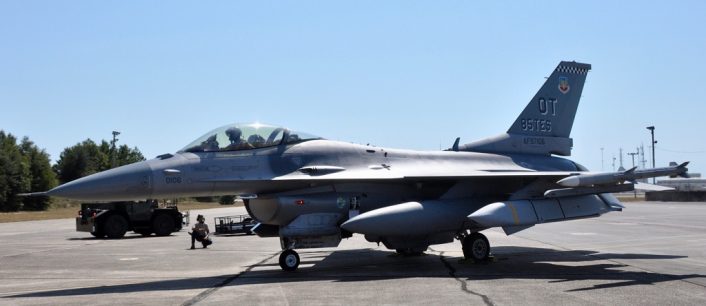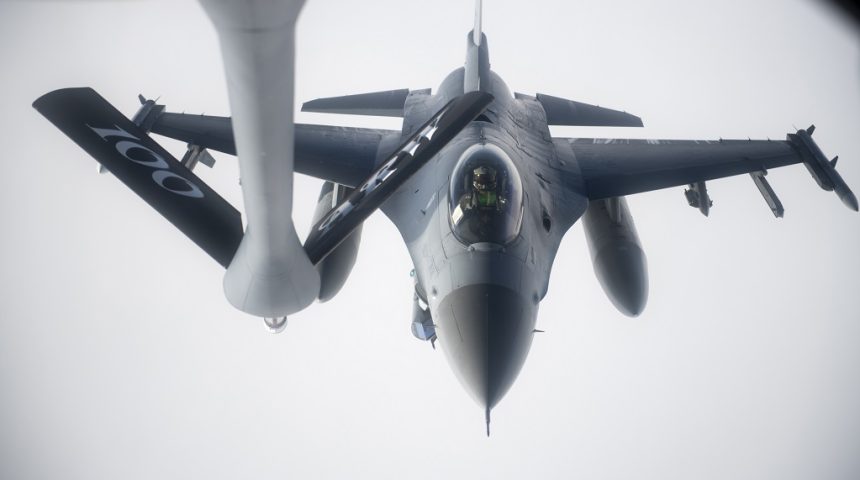The new Multi-Domain exercise follows the lead of the last summer’s drills, while continuing to increase the presence of the United States in the Black Sea region.
The U.S. Air Forces in Europe and Air Forces Africa led a Joint All-Domain Command and Control (JADC2) exercise, designed to train U.S. and ally forces to integrate, operate and communicate while executing all-domain targeting operations, over the Black Sea on January 14, 2020. The exercise, dubbed “Prime Accord”, saw the participation also of the U.S. Special Operations Command Europe, U.S Naval Forces Europe/U.S. 6th Fleet, U.S. Army Europe and Africa, U.S. Strategic Command and the Romanian Air Force.
“Our forward presence and strong bilateral relationship with our friend and ally, Romania, ensures our ability to respond to any threat with confidence,” said Gen. Jeff Harrigian, USAFE-AFAFRICA commander. “Enhancing our joint lethality is crucial to preparing Airmen to execute the mission.”
A number of aircraft were confirmed being involved in the drill, some of them visible on flight tracking websites through ADS-B and MLAT:
- A P-8A Poseidon from NAS Sigonella assigned to either Patrol Squadrons VP-9 Golden Eagles or VP-46 Grey Knights (currently deployed there), reportedly Bu.No. 168760, transmitting with Mode-S hex code AE67F4;
- Two KC-135R from RAF Mildenhall assigned to the 100th Aerial Refueling Wing, QID734, QID751, with AF Ser. No. 63-8878 and 61-0292, respectively;
- Two U.S. Air Force F-16CM-40s from the 31st Fighter Wing at Aviano Air Base assigned to the 555th FS “Triple Nickel”, reportedly transmitting the callsigns NICKEL 61 and 62;
- Four Romanian Air Force F-16A-MLU from the 86th Air Base in Borcea;
- A RQ-4B Global Hawk from NAS Sigonella which was tracked with the usual callsign FORTE 10, reportedly AF Ser. No. 11-2049, transmitting with Mode-S hex code AE54B6.
USAF Global Hawk FORTE10
US Navy P8 Poseidon AE67F4 pic.twitter.com/xEZ2i1eavQ
— Manu Gómez (@GDarkconrad) January 14, 2021
14 JAN 2021#USAF aviation activity observed today in the BS Reg-n:
U-2 (BENT-01) from RAF Akrotiri
RQ-4 (FORTE-10) from NAS Sigonella
2×KC-135s (QUID-751/734) from RAF Mildenhall
2×F-16s (NICKEL-61/62) from Aviano AB
F-16s are of particular interest, as pos. carriers of B61-3/-4 pic.twitter.com/WzPm3nMmZn
— Cyber Diver (@Some_Sun) January 14, 2021
Some sources mentioned also the possible participation of a U-2S Dragon Lady forward deployed at RAF Akrotiri, Cyprus, but this has not been confirmed by neither the U.S. nor Romania. Available MLAT tracks show however that a U-2 did indeed depart from Akrotiri that day, but it was headed to the Middle East. U-2s deployed there can often be tracked while departing for their missions and, sometimes, while descending during the approach and landing back on the island.
The main protagonists of the exercise were the F-16 Fighting Falcons of the 31st Fighter Wing and the F-16s of the Romanian Air Force. The U.S. F-16s took off from Aviano Air Base, Italy, and, supported by the two KC-135 tankers, flew to the Black Sea where they conducted training scenarios utilizing AGM-158 Joint Air-to-Surface Missile (JASSM) employment tactics, while the RoAF F-16s provided fighter escort. The drill took place in front of Romania’s and Bulgaria’s coasts, where the aircraft were tracked circling, possibly while performing Air-to-Air Refueling (AAR).
The Poseidon was flying its usual ISR patrol (Intelligence, Surveillance, Reconnaissance) west of the Crimean Peninsula, while the Global Hawk initially flew its usual ISR patrol around Crimea and then proceeded to establish a new patrol over Georgia. Similar patrols were tracked also in December, possibly in the aftermath of the recent Nagorno-Karabakh conflict between Armenia and Azerbaijan.
Forte10 GlobalHawk RQ-4B is right there as well. pic.twitter.com/LoNk5AErLb
— IntelAssess (@812Z_) January 14, 2021
The exercise was coordinated by a joint team at the Romanian Control and Reporting Center, where the 606th Air Control Squadron from the 31st FW and the 1st Combat Communications Squadron from the 435th Air Ground Operations Wing at Ramstein Air Base, Germany, were deployed to assist in providing tactical command and control together with the RoAF personnel.
“The Romanian CRC participation bloomed into additional U.S. personnel deploying to Romania to employ C2 with the Romanians,” said U.S. Air Force Lt. Col. Alex Riseborough, air attaché at the U.S. Embassy in Bucharest. “It was a U.S. first and a big step for our bilateral Air Force partnership with the Romanians.”
This exercise is highly similar to another one conducted last summer, when Aviano’s F-16s again simulated the usage of the JASSM during multi-domain operations. Even if just simulated, the employment of stand-off weapons like the JASSM in the Black Sea region is highly significant.
The AGM-158 JASSM (with a range in excess of 200 nautical miles) and its extended-range version, the AGM-158B Joint Air-to-Surface Standoff Missile – Extended Range (JASSM-ER) with a standoff distance of over 500 nautical miles, are GPS-guided radar-evading cruise missiles with 2,250-lbs penetrator/blast fragmentation warhead. The JASSM cruise missile employs precision routing and guidance in adverse weather, day or night, using an infrared seeker in addition to the anti-jam GPS to find and destroy high-value, well-defended targets.

In the same period, B-1B Lancers from the 28th Bomb Wing, based at Ellsworth Air Force Base, performed a Bomber Task Force Europe mission over the same area, focused on training on the Long Range Anti-Ship Missile capability with the AGM-158C LRASM against unspecified new emerging threats.
The AGM-158C LRASM, based on the AGM-158B JASSM-ER, is the new low-observable anti-ship cruise missile developed by DARPA (Defense Advanced Research Projects Agency) for the U.S. Air Force and U.S. Navy. The missile, armed with a 1000 lb (454 kg) penetrator and blast fragmentation warhead, is capable of performing all-weather precision routing and guidance through pre-planned waypoints, before transitioning to mid-course guidance through its multimodal sensor and later to low altitude navigation for target identification and final approach. The LRASM is also equipped with Electronic Support Measure (ESM), Radar Warning Receiver (RWR) and Artificial Intelligence (AI) for threat avoidance and target recognition.
Back to last week’s exercise, the press release did not provide many details about the ground assets’ involvement. SOCEUR deployed conventional and Special Operations Forces to integrate training with Close Air Support (CAS) missions and simulated strikes on targets of interest. The Army deployed the 41st Field Artillery Brigade and the 10th Army Air Missile Defense Command, but their role was not specified.
In November, the 41st FAB deployed two M142 High Mobility Artillery Rocket Systems (HIMARS) to Romania using an MC-130J Commando II and a C-130 Hercules, performing what is called as a HIMARS Rapid Infiltration (HIRAIN), and firing at targets in the Black Sea during a joint exercise with Romanian forces. It is not known if they performed in a similar role last week.
The United States are increasing their military presence in Romania, not only with joint exercises, but also with deployed forces. This month the U.S. Air Force announced that an unspecified number of MQ-9 Reaper drones, accompanied by approximately 90 Airmen, are now at the 71st Air Base in Campia Turzii Air Base, from where they will conduct intelligence, surveillance and reconnaissance (ISR) missions in support of NATO operations in the region.









